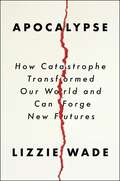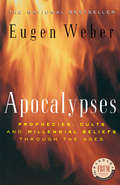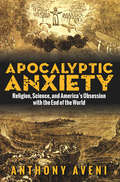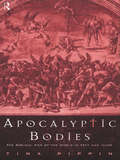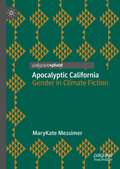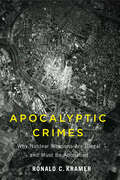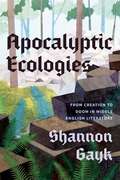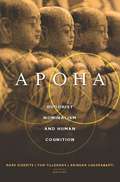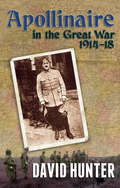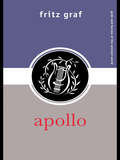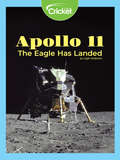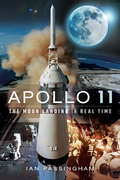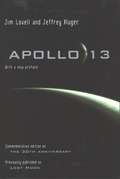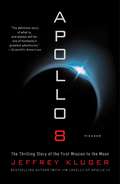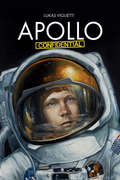- Table View
- List View
Apocalypse: How Catastrophe Transformed Our World and Can Forge New Futures
by Lizzie WadeA Next Big Idea Club Must-Read Book of May 2025 • A Publishers Weekly Most Anticipated History Book of the Year • A The Millions Most Anticipated Spring Book of the Year"Lizzie Wade is an exceptional journalist and a master storyteller. She reminds us that survival always has been, and still is, possible, and that our world always has been, and still is, a choice." –Ed Yong, author of An Immense World“This book upended my understanding of the ancient world. Wade renders our deep past in vivid prose, showing us that times of great rupture also bring great possibilities for new ways of living, if we let them. Apocalypse is the best kind of history book: vibrant and vital.” —Zoë Schlanger, author of The Light EatersA richly imagined new view on the great human tradition of apocalypse, from the rise of Homo sapiens to the climate instability of our present, that defies conventional wisdom and long-held stories about our deep past to reveal how cataclysmic events are not irrevocable endings, but transformations.A drought lasts for decades, a disease rips through a city, a civilization collapses. When we finally uncover the ruins, we ask: What happened? The good news is, we’ve been here before. History is long, and people have already confronted just about every apocalypse we’re facing today. But these days, archaeologists are getting better at seeing stories of survival, transformation, and even progress hidden within those histories of collapse and destruction. Perhaps, we begin to see, apocalypses do not destroy worlds, but create them anew.Apocalypse offers a new way of understanding human history, reframing it as a series of crises and cataclysms that we survived, moments of choice in an evolution of humanity that has never been predetermined or even linear. Here Lizzie Wade asks us to reckon with our long-held narratives of these events, from the end of Old Kingdom Egypt, the collapse of the Classic Maya, to the Black Death, and shows us how people lived through and beyond them—and even considered what a new world could look like in their wake.The more we learn about apocalypses past, the more hope we have that we will survive our own. It won’t be pleasant. It won’t be fair. The world will be different on the other side, and our cultures and communities—perhaps even our species—will be different too.
Apocalypses
by Eugen WeberEugen Weber delivered the Barbara Frum Historical Lecture, based on Apocalypses, at the University of Toronto in March 1999. This annual lecture "on a subject of contemporary history in historical perspective" was established in memory of Barbara Frum.Apocalypses Prophecies, Cults and Millennial Beliefs through the AgesThe Barbara Frum Historical LectureshipA national bestsellerWhat drove eminent historian Eugen Weber to write Apocalypses? His desire to redress the historical and religious amnesia that has consigned the study of apocalyptic and millennialist thought to the lunatic fringe. An absolute belief in the end time was omnipresent until the 17th century, and retains many adherents even now. Apocalyptic visions and prophecies inspired crusades, scientific discoveries, works of art, voyages such as those of Columbus, rebellions and reforms. Elegantly written, as witty and entertaining as it is profound, Apocalypses displays Eugen Weber's talents as a stylist and historical detective; this is more a travel book of the apocalypse than a definitive academic treatment. On the eve of a billennium beset by a host of apocalyptic predictions and cults, Apocalypses offers a sympathetic review of creeds we ignore at our peril.
Apocalyptic Anxiety: Religion, Science, and America's Obsession with the End of the World
by Anthony AveniApocalyptic Anxiety traces the sources of American culture’s obsession with predicting and preparing for the apocalypse. Author Anthony Aveni explores why Americans take millennial claims seriously, where and how end-of-the-world predictions emerge, how they develop within a broader historical framework, and what we can learn from doomsday predictions of the past. The book begins with the Millerites, the nineteenth-century religious sect of Pastor William Miller, who used biblical calculations to predict October 22, 1844 as the date for the Second Advent of Christ. Aveni also examines several other religious and philosophical movements that have centered on apocalyptic themes—Christian millennialism, the New Age movement and the Age of Aquarius, and various other nineteenth- and early twentieth-century religious sects, concluding with a focus on the Maya mystery of 2012 and the contemporary prophets who connected the end of the world as we know it with the overturning of the Maya calendar. Apocalyptic Anxiety places these seemingly never-ending stories of the world’s end in the context of American history. This fascinating exploration of the deep historical and cultural roots of America’s voracious appetite for apocalypse will appeal to students of American history and the histories of religion and science, as well as lay readers interested in American culture and doomsday prophecies.
Apocalyptic Bodies: The Biblical End of the World in Text and Image
by Tina PippinApocalyptic Bodies traces the biblical notions of the end of the world as represented in ancient and modern texts, art, music and popular culture, for example the paintings of Bosch. Tina Pippin addresses the question of how far we, in the late twentieth century, are capable of reading and responding to the 'signs of the times'. It will appeal not only to those studying religion, but also to those fascinated with interpretations of the end of the world.
Apocalyptic California: Gender in Climate Fiction
by MaryKate MessimerThis book explores concepts of environmentalism and feminism in science fiction novels written by women. By extrapolating the future of climate change, the authors of these texts model how readers can apply utopian feminist and environmental theories in their own lives. Chapter One establishes an understanding of ecofeminist environmental thinking through original research conducted at the Ursula K. Le Guin archive at the University of Oregon. Chapter Two shows an example of climate change dystopia set in California in Claire Vaye Watkins’ novel Gold Fame Citrus. The final chapters explore utopian visions of queer ecologies in books by Octavia Butler and N.K. Jemisin. Because climate change is so difficult for individuals to grapple with, a new perspective is needed to survive it. The queer ecological philosophy in these novels points to a way of life that can reduce environmental harm in an era of climate change.
Apocalyptic Crimes: Why Nuclear Weapons Are Illegal and Must Be Abolished (Critical Issues in Crime and Society)
by Ronald C. KramerIn 2023, the Bulletin of the Atomic Scientists set the iconic Doomsday Clock to ninety seconds to midnight—the closest to midnight, or civilization-ending apocalypse, it has ever been. Designed at the onset of the Cold War amid new fears of atomic weapons, the Doomsday Clock is a symbolic countdown to annihilation. Now, a generation later, the world is more vulnerable than ever to the nuclear weapons it sought to warn against. In Apocalyptic Crimes, Ronald C. Kramer reconsiders the immense danger these weapons pose to humanity, examining the use, threat to use, and continued possession of nuclear weapons from a criminological perspective. Kramer argues that any country holding on to its nuclear arsenal—including the United States—is committing a criminal act. Offering a sharp rebuke to the common claim that nuclear stockpiles serve to deter the escalation of conflict, Apocalyptic Crimes emphasizes the harm caused by the mere possession of these deadly weapons. It further considers the culpability of political officials, acting as representatives of the state, whose threatening statements about nuclear weapons contain actions or omissions that violate specific international laws. But Kramer also shows how a nuclear apocalypse might be averted and offers a pathway to disarmament. Through critical analysis and a specific criminology of nuclear weapons, Kramer outlines the political actions necessary to rewind the Doomsday Clock and pull the world back from the brink of destruction—before the clock strikes midnight.
Apocalyptic Ecologies: From Creation to Doom in Middle English Literature
by Shannon GaykA meditative reflection on what medieval disaster writing can teach us about how to respond to the climate emergency. When a series of ecological disasters swept medieval England, writers turned to religious storytelling for precedents. Their depictions of biblical floods, fires, storms, droughts, and plagues reveal an unsettled relationship to the natural world, at once unchanging and bafflingly unpredictable. In Apocalyptic Ecologies, Shannon Gayk traces representations of environmental calamities through medieval plays, sermons, and poetry such as Cleanness and Piers Plowman. In premodern disaster writing, she recovers a vision of environmental flourishing that could inspire new forms of ecological care today: a truly apocalyptic sensibility capable of seeing in every ending, every emergency a new beginning waiting to emerge.
Apocalyptic Geographies: Religion, Media, and the American Landscape
by Jerome TharaudHow nineteenth-century Protestant evangelicals used print and visual media to shape American cultureIn nineteenth-century America, "apocalypse" referred not to the end of the world but to sacred revelation, and "geography" meant both the physical landscape and its representation in printed maps, atlases, and pictures. In Apocalyptic Geographies, Jerome Tharaud explores how white Protestant evangelicals used print and visual media to present the antebellum landscape as a “sacred space” of spiritual pilgrimage, and how devotional literature influenced secular society in important and surprising ways.Reading across genres and media—including religious tracts and landscape paintings, domestic fiction and missionary memoirs, slave narratives and moving panoramas—Apocalyptic Geographies illuminates intersections of popular culture, the physical spaces of an expanding and urbanizing nation, and the spiritual narratives that ordinary Americans used to orient their lives. Placing works of literature and visual art—from Thomas Cole’s The Oxbow to Harriet Beecher Stowe’s Uncle Tom’s Cabin and Henry David Thoreau’s Walden—into new contexts, Tharaud traces the rise of evangelical media, the controversy and backlash it engendered, and the role it played in shaping American modernity.
Apocalyptic Movements in Contemporary Politics
by Carlo AldrovandiThis book explores Israeli Religious Zionism and US Christian Zionism by focusing on the Messianic and Millenarian drives at the basis of their political mobilization towards a 'Jewish colonization' of the occupied territories.
Apocalyptic Realm
by Dilip HiroThis hard-hitting and timely book explores the roots of militant Islam in South Asia and how it has grown to become a source of profound global alarm. By meticulously tracking the rise of the jihadist movement from its initial violence in Afghanistan in 1980 to the present day, Dilip Hiro challenges conventional narratives of the roles of Afghanistan, Pakistan, the Soviet Union, the United States, and India. He warns that the Line of Control in Kashmir, where jihadists seek to incite war between nuclear-armed Pakistan and India, is today the most dangerous border in the world. Drawing on evidence from a wide variety of sources including newly released Kremlin archives and classified U. S. Embassy documents published by WikiLeaks, the author compiles the first complete and accurate history of Islamist terrorism in South Asia. He chronicles historic links between Pakistan, Afghanistan, and India and their varying degrees of destabilization at the hands of the jihadists. He also sheds unprecedented light on the close military and intelligence links that have developed between India and Israel. Finally, he outlines the ambitions of Pakistani, Afghan, and Al Qaeda jihadists to establish an "apocalyptic realm" covering South, Central, and Western Asia. Compact, comprehensive, and fast paced, this book lays bare the causes of today's escalating terrorist threat, sets the historical record straight, and offers fresh strategies for defeating jihadist extremism.
Apocalypticism in the Dead Sea Scrolls (The Literature of the Dead Sea Scrolls)
by John J. CollinsSince the photographs of the Dead Sea Scrolls were released in 1992, there has been an explosion of interest in them. This volume explores the issue of apocalypticism in the Scrolls; how the notions of the 'end', Messianic expectation and eternal life affected the Dead Sea sect, influenced Judaism and filtered into Christianity. Collins' volume provides a valuable and accessible introduction to the interpretation of the Scrolls, which is an informative addition to the series examining the major themes of the Scroll texts.
Apogee of Empire: Spain and New Spain in the Age of Charles III, 1759–1789
by Stanley J. Stein Barbara H. SteinOnce Europe's supreme maritime power, Spain by the mid-eighteenth century was facing fierce competition from England and France. England, in particular, had successfully mustered the financial resources necessary to confront its Atlantic rivals by mobilizing both aristocracy and merchant bourgeoisie in support of its imperial ambitions. Spain, meanwhile, remained overly dependent on the profits of its New World silver mines to finance both metropolitan and colonial imperatives, and England's naval superiority constantly threatened the vital flow of specie.When Charles III ascended the Spanish throne in 1759, then, after a quarter-century as ruler of the Kingdom of the Two Sicilies, Spain and its colonial empire were seriously imperiled. Two hundred years of Hapsburg rule, followed by a half-century of ineffectual Bourbon "reforms," had done little to modernize Spain's increasingly antiquated political, social, economic, and intellectual institutions. Charles III, recognizing the pressing need to renovate these institutions, set his Italian staff—notably the Marqués de Esquilache, who became Secretary of the Consejo de Hacienda (the Exchequer)—to this formidable task.In Apogee of Empire, Stanley J. Stein and Barbara H. Stein trace the attempt, initially under Esquilache's direction, to reform the Spanish establishment and, later, to modify and modernize the relationship between the metropole and its colonies. Within Spain, Charles and his architects of reform had to be mindful of determining what adjustments could be made that would help Spain confront its enemies without also radically altering the Hapsburg inheritance. As described in impressive detail by the authors, the bitter, seven-year conflict that ensued between reformers and traditionalists ended in a coup in 1766 that forced Charles to send Esquilache back to Italy. After this setback at home, Charles still hoped to effect constructive change in Spain's imperial system, primarily through the incremental implementation of a policy of comercio libre (free-trade). These reforms, made half-heartedly at best, failed as well, and by 1789 Spain would find itself ill prepared for the coming decades of upheaval in Europe and America.An in-depth study of incremental response by an old imperial order to challenges at home and abroad, Apogee of Empire is also a sweeping account of the personalities, places, and policies that helped to shape the modern Atlantic world.
Apoha: Buddhist Nominalism and Human Cognition
by Mark Tom Tillemans Arindam Chakrabarti Eds. SideritsWhen we understand that something is a pot, is it because of one property that all pots share? This seems unlikely, but without this common essence, it is difficult to see how we could teach someone to use the word "pot" or to see something as a pot. The Buddhist apoha theory tries to resolve this dilemma, first, by rejecting properties such as "potness" and, then, by claiming that the element uniting all pots is their very difference from all non-pots. In other words, when we seek out a pot, we select an object that is not a non-pot, and we repeat this practice with all other items and expressions.Writing from the vantage points of history, philosophy, and cognitive science, the contributors to this volume clarify the nominalist apoha theory and explore the relationship between apoha and the scientific study of human cognition. <P><P>They engage throughout in a lively debate over the theory's legitimacy. Classical Indian philosophers challenged the apoha theory's legitimacy, believing instead in the existence of enduring essences. Seeking to settle this controversy, essays explore whether apoha offers new and workable solutions to problems in the scientific study of human cognition. They show that the work of generations of Indian philosophers can add much toward the resolution of persistent conundrums in analytic philosophy and cognitive science.
Apollinaire in the Great War (1914-18)
by David HunterA major literary figure in pre-war Paris, Guillaume Apollinaire volunteered for war in 1914, trained as an artilleryman and was posted in April 1915 to the Champagne front in northern France, participating in the bloody but little-known offensive that September and then moving into the front line as an infantry officer, before being wounded in March 1916 and invalided out of active service. Back in Paris, Apollinaire plunged back into the activities of the capital's artistic avant-garde, meanwhile publishing poetry, prose and plays that were deeply influenced by his involvement in the conflict. He died on 9 November 1918, two days before the Armistice, a victim of the influenza pandemic, but with a literary reputation secured, as well as a certain fame for coining the term 'Surrealism'. This book draws heavily on Apollinaire's writings to tell the story of his war years, within the wider context of the French experience of the Great War. In this period, Apollinaire also wrote hundreds of letters, the bulk of them to two women: Louise de Coligny, a flighty socialite of aristocratic origin, and Madeleine Pagès, a young schoolteacher. In these letters he poured out his passionate feelings for both in often highly erotic poetry and prose, as well as giving detailed descriptions of his life as a front-line soldier.
Apollo (Gods and Heroes of the Ancient World)
by Fritz GrafFritz Graf here presents a survey of a god once thought of as the most powerful of gods, and capable of great wrath should he be crossed: Apollo the sun god. From his first attestations in Homer, through the complex question of pre-Homeric Apollo, to the opposition between Apollo and Dionysos in nineteenth and twentieth-century thinking, Graf examines Greek religion and myth to provide a full account of Apollo in the ancient world. For students of Greek religion and culture, of myth and legend, and in the fields of art and literature, Apollo will provide an informative and enlightening introduction to this powerful figure from the past.
Apollo 1 in Photographs: The Apollo Photo Archive
by John Bisney J. L. Pickering Ed HengeveldThe Project Apollo in Photographs series features tens of thousands of previously unpublished images from the J.L. Pickering collection.
Apollo 11 Q&A: 175+ Fascinating Facts for Kids (History Q&A)
by Kelly Milner Halls175+ fascinating facts that teach kids ages 8 to 12 how we got to the moon From cube-shaped astronaut foods to the famous moon walk, there are so many incredible things for kids to learn about the Apollo 11 mission. This engaging guide introduces kids to the legacy of Apollo 11 through short, fun Q&As. They'll see how awesome learning can be as they read about spaceships, astronauts, space suits, and more—one easy-to-understand answer at a time. Go beyond other Apollo 11 books for kids with: New ways to learn—Launch kids into the history of the Apollo 11 mission with Q&As, true or false questions, and fun facts. Shareable history—This book is packed full of bite-sized bits of history that are both memorable and exciting for kids to tell their friends and family. A complete overview—From the start of the space race to the ways the Apollo 11 mission still affects modern space travel, kids will get a comprehensive look at America's space program. Spark a lifelong love of history in young astronauts with this top choice in space books for kids.
Apollo 11: The Eagle Has Landed
by Leigh AndersonHave you ever looked into the night sky and wished that you could walk on the Moon? Find about what it is like from the astronauts that were first to do it! Learn about how Neil Armstrong, Edwin Aldrin, and Michael Collins traveled into space and created history in 1969, and what it was like to take those famous first steps that made “one giant leap for mankind."
Apollo 11: The Moon Landing in Real Time
by Ian PassinghamA day-by-day account of the 1969 Apollo 11 Moon landing—from launch prep to the crews&’ return to Earth—by the author of 66: The World Cup In Real Time. Half a century has passed since arguably the greatest feat of the twentieth century: when Neil Armstrong became the first man to walk on the moon. Apollo 11: The Moon Landing In Real Time brings the mission back to life as never before in a thrilling day-by-day account, exploring everything from the historic flight itself to how the $24-billion space program divided a nation. Journey back in time and feel the excitement build in the days before launch, and then experience the tension of the dramatic lunar landing and the relief of the crew&’s safe return to Earth. This engaging account mixes easily understandable explanations of the groundbreaking technology behind Apollo 11 with entertainment, excitement, and humor in equal measure. Set against a backdrop of the Cold War, race riots, and the Vietnam War, the mission polarized opinion worldwide. Alongside these issues, read long-forgotten tales including how a Chilean lawyer claimed he was the legal owner of the Moon, thousands of people signed up for proposed commercial Moon flights, Hilton revealed plans for a lunar hotel, &“flat Earth&” believers claimed the mission was a hoax, and some scientists feared the astronauts would bring back deadly germs from space which would devastate mankind. &“A most enjoyable read.&” —Quest: The History of Spaceflight Quarterly
Apollo 13 (Totally True Adventures)
by Kathleen Weidner Zoehfeld Wesley LoweCould you survive an outer-space disaster? Aspiring astronauts and young explorers will love this out-of-this-world Totally True Adventure. Astronauts Jim Lovell, Jack Swigert, and Fred Haise blasted off for the Moon on April 11, 1970. But after a disastrous explosion damaged their spacecraft, the three men had only one goal: to get back home safely. This informational text makes space travel exciting and accessible for younger readers and features illustrations, photographs, a map, and additional Story Behind the Story facts. Perfect for readers of the I Survived series and the Who Was series, Totally True Adventures are captivating nonfiction stories with not-to-be-missed bonus content.
Apollo 13: Lost Moon
by Jeffrey Kluger James LovellIn April 1970, during the glory days of the Apollo space program, NASA sent Navy Captain Jim Lovell and two other astronauts on America's fifth mission to the moon. Only fifty-five hours into the flight of Apollo 13, disaster struck: a mysterious explosion rocked the ship, and soon its oxygen and power began draining away. Written with all the color and drama of the best fiction, APOLLO 13 (previously published as Lost Moon) tells the full story of the moon shot that almost ended in catastrophe. Minutes after the explosion, the three astronauts are forced to abandon the main ship for the lunar module, a tiny craft designed to keep two men alive for just two days. As the hours tick away, the narrative shifts from the crippled spacecraft to Mission Control, from engineers searching desperately for a way to fix the ship to Lovell's wife and children praying for his safe return. The entire nation watches as one crisis after another is met and overcome. By the time the ship splashes down in the Pacific, we understand why the heroic effort to rescue Lovell and his crew is considered by many to be NASA's finest hour.Now, thirty years after the launch of the mission, Jim Lovell and coauthor Jeffrey Kluger add a new preface and never-before-seen photographs to Apollo 13. In their preface, they offer an incisive look at America's waxing and waning love affair with space exploration during the past three decades, culminating only recently when the Apollo 13 spacecraft itself, long consigned to an aviation museum outside Paris, was at last returned to its rightful home in the United States. As inspiring today as it was thirty years ago, the story of Apollo 13 is a timeless tribute to the enduring American spirit and sparkling individual heroism.
Apollo 1: The Tragedy That Put Us on the Moon
by Ryan S. WaltersOn January 27, 1967, astronauts Gus Grissom, Ed White, and Roger Chaffee climbed into a new spacecraft perched atop a large Saturn rocket at Kennedy Space Center in Florida for a routine dress rehearsal of their upcoming launch into orbit, then less than a month away. All three astronauts were experienced pilots and had dreams of one day walking on the moon. But little did they know, nor did anyone else, that once they entered the spacecraft that cold winter day they would never leave it alive. The Apollo program would be perilously close to failure before it ever got off the ground.But rather than dooming the space program, this tragedy caused the spacecraft to be completely overhauled, creating a stellar flying machine to achieve the program&’s primary goal: putting man on the moon.Apollo 1 is a candid portrayal of the astronauts, the disaster that killed them, and its aftermath. In it, readers will learn:How the Apollo 1 spacecraft was doomed from the start, with miles of uninsulated wiring and tons of flammable materials in a pure oxygen atmosphere, along with a hatch that wouldn&’t openHow, due to political pressure, the government contract to build the Apollo 1 craft went to a bidder with an inferior planHow public opinion polls were beginning to turn against the space program before the tragedy and got much worse afterApollo 1 is about America fulfilling its destiny of man setting foot on the moon. It&’s also about the three American heroes who lost their lives in the tragedy, but whose lives were not lost in vain.
Apollo 7 in Photographs: The Apollo Photo Archive
by John Bisney J. L. Pickering Ed HengeveldThe Apollo Photo Archive series comprises the most comprehensive pictorial record of America&’s moon-landing program ever published. The series continues with Apollo 7&’s launch in October 1968. Crewed by Wally Schirra, Donn Eisele, and Walt Cunningham, it was the first successful Apollo space flight. Less than two years after the Apollo 1 disaster in January 1967, the success of Apollo 7 helped redirect the course of the Apollo program and, therefore, space history. Readers will enjoy more than 700 photos, which feature the arrival and assembly of the rocket and spacecraft, crew selection and training, preflight activities, mission countdown, launch, the flight itself, splashdown, and subsequent crew appearances and related activities.
Apollo 8: The Thrilling Story of the First Mission to the Moon
by Jeffrey KlugerThe untold story of the historic voyage to the moon that closed out one of our darkest years with a nearly unimaginable triumphIn August 1968, NASA made a bold decision: in just sixteen weeks, the United States would launch humankind’s first flight to the moon. Only the year before, three astronauts had burned to death in their spacecraft, and since then the Apollo program had suffered one setback after another. Meanwhile, the Russians were winning the space race, the Cold War was getting hotter by the month, and President Kennedy’s promise to put a man on the moon by the end of the decade seemed sure to be broken. But when Frank Borman, Jim Lovell and Bill Anders were summoned to a secret meeting and told of the dangerous mission, they instantly signed on.Written with all the color and verve of the best narrative non-fiction, Apollo 8 takes us from Mission Control to the astronaut’s homes, from the test labs to the launch pad. The race to prepare an untested rocket for an unprecedented journey paves the way for the hair-raising trip to the moon. Then, on Christmas Eve, a nation that has suffered a horrendous year of assassinations and war is heartened by an inspiring message from the trio of astronauts in lunar orbit. And when the mission is over—after the first view of the far side of the moon, the first earth-rise, and the first re-entry through the earth’s atmosphere following a flight to deep space—the impossible dream of walking on the moon suddenly seems within reach. The full story of Apollo 8 has never been told, and only Jeffrey Kluger—Jim Lovell’s co-author on their bestselling book about Apollo 13—can do it justice. Here is the tale of a mission that was both a calculated risk and a wild crapshoot, a stirring account of how three American heroes forever changed our view of the home planet.
Apollo Confidential: Memories of Men On the Moon
by Lukas VigliettiThe inside stories of the Apollo program and the live of astronauts, as told to the author by the men themselves—with a forward by astronaut Charlie Duke. Between 1969 and 1972, twelve people walked on the surface of the Moon. Twelve others flew over its majestic surface. They were the sons of ordinary individuals. But they believed anything was possible―and they proved it to the entire world. Fascinated by these men—heroes such as Alan Shepard, Neil Armstrong, Buzz Aldrin, and many others—airline pilot Lukas Viglietti personally recorded their testimonies, becoming a close friend and confidant to many of them in the process. Now he shares his exclusive and unprecedented insight into their adventures and the Apollo program overall in Apollo Confidential.
